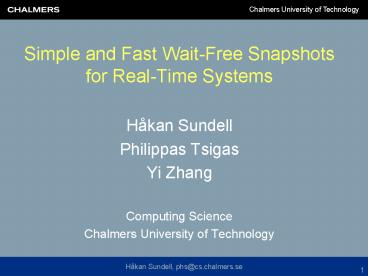Simple and Fast WaitFree Snapshots for RealTime Systems PowerPoint PPT Presentation
1 / 29
Title: Simple and Fast WaitFree Snapshots for RealTime Systems
1
Simple and Fast Wait-Free Snapshots for Real-Time
Systems
- Håkan Sundell
- Philippas Tsigas
- Yi Zhang
- Computing Science
- Chalmers University of Technology
2
Schedule
- Real-Time System
- Synchronization
- Algorithm
- Bounding
- Experiments
- Conclusions
- Future work
3
Real-Time System
- Multiprocessor system
- Interconnection Network
- Shared memory
CPU
CPU
CPU
CPU
4
Real-Time System
- Cooperating Tasks
- Timing constraints
- Need synchronization
- Shared Data Objects
- In this paper Atomic Snapshot
5
Synchronization
- Synchronization methods
- Lock
- Uses semaphores, spinning, disabling interrupts
- Negative
- Blocking
- Priority inversion
- Risk of deadlock
- Positive
- Execution time guarantees easy to do
Take lock ... do operation ... Release lock
6
Synchronization
- Synchronization methods
- Lock-free
- Retries until not interfered by other operations
- Usually uses some kind of shared flag variable
Write flag with unique value ... do operation
... Check flag value and maybe retry
7
Synchronization
- Synchronization methods
- Lock-free
- Negative
- No execution time guarantees, can continue
forever - thus can cause starvation - Positive
- Avoids blocking and priority inversion
- Avoids deadlock
- Fast execution when low contention
8
Synchronization
- Synchronization methods
- Wait-free
- Uses atomic synchronization primitives
- Uses shared memory
- Negative
- Complex algorithms
- Memory consuming
TestSet Compare Swap Copying Helping Announcing
Split operation ???
9
Synchronization
- Synchronization methods
- Wait-free
- Positive
- Execution time guarantees
- Fast execution
- Avoids blocking and priority inversion
- Avoids deadlock
- Avoids starvation
- Same implementation on both single- and
multiprocessor systems
10
Snapshot
- Shared variables
- Read / Write registers
- Some values are related together
11
Snapshot
- Snapshot
- A consistent momentous state of a set of several
shared variables - One reader
- Reads the whole set of variables in one atomic
step - Many writers
- Writes to only one variable each time
12
Linearizability
- Atomicity / Linearizability criteria
ci
Write
Write
NO
Write
cj
t
Read
YES
ci
t
Write
Write
Read
YES
ci
t
Write
Write
returned by scanner
13
Linearizability
- Atomicity / Linearizability criteria
Read
NO
ci
t
Write
Write
Read
NO
ci
t
Write
Write
returned by scanner
14
Linearizability
- If all of those criteria are fulfilled then our
snapshot algorithm are linearizable - All operations can be transformed into a serial
sequence of atomic operations
15
Algorithm
- Wait-Free Snapshot Algorithm
- Unbounded memory
- Each component represented by an infinite
nil-value-initialized array, higher index for
more recent values - A global index register where all component
writers writes the updated value - The reader scans all component arrays backwards
from current position
16
Algorithm
- Unbounded Snapshot Protocol
Snapshotindex
? previous values / nil w writer position
v
?
?
?
?
w
nil
nil
c1
ci
v
?
?
?
?
w
nil
nil
cc
v
?
?
?
?
w
nil
nil
t
17
Bounding
- We must recycle the array indexes in some way
- Keep track of the scanner versus the updaters
positions - Previous solution by Ermedahl et. al
- Synchronized using atomic Test and Set operations
18
Bounding
int TestAndSet(int p) atomic if(!p)
p1return 1 else return 0
- Solution in real-time systems
- Using timing information!
19
Bounding
- Assuming system with periodic fixed-priority
scheduling - Notations from Standard Real-Time Response Time
Analysis - Use information about
- Periods , T
- Computation time , C
- Response times , R
20
Bounding
- Use cyclical buffers
- Keep track that updater position is always behind
the scanner so that new positions are always free
21
Bounding
- Needed buffer length is dependent on how fast the
updaters is compared to the scanner - Each component can have different buffer lengths
22
Bounding
- Needed buffer length for component k
- Can be refined even further
where Ts is the period for the snapshot task Tw
is the period for the writer tasks
23
Experiments
- Using a Sun Enterprise 10000 multiprocessor
computer - 1 scanner task and 10 updater tasks, one on each
cpu - Comparing two wait-free snapshot algorithms
- Using timing information
- Using test and set synchronization
24
Experiments
- Measuring response time for scan versus update
operations - All updaters have the same period
- All 10 components have the same buffer lengths
for the algorithm using timing information - The algorithm using test and set synchronization
uses a buffer of length 3
25
Experiments
- 7 different scenarios
26
Experiments
- Scan operation - Average Response Time
27
Experiments
- Update operation Average Response Time
28
Conclusions
- Update operation
- Using timing information gives up to 400 better
performance - Scan operation
- Using timing information gives up to 20 better
performance in common practical scenarios - Update operation is much more frequent than Scan
- Timing information can improve the performance
significantly - Simpler algorithm
29
Future work
- Investigations of other wait-free synchronization
methods - Implementations in RTOS kernels

